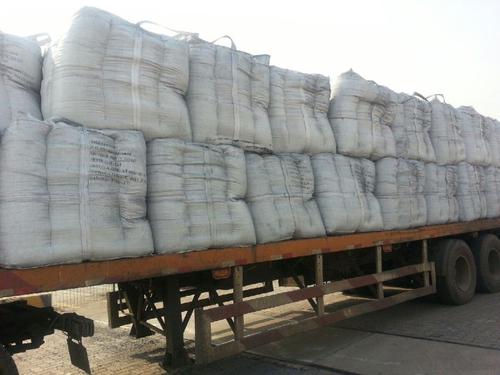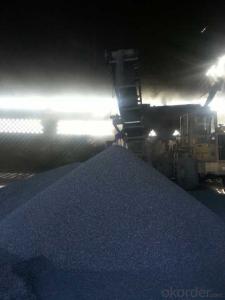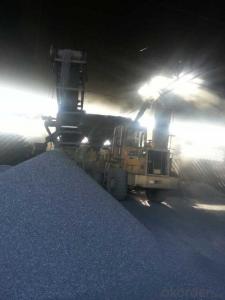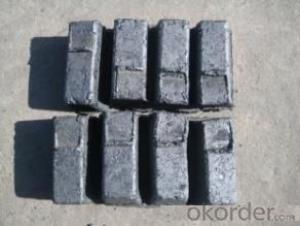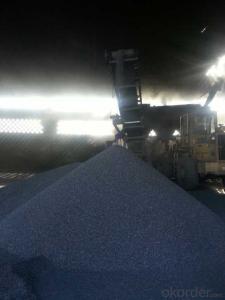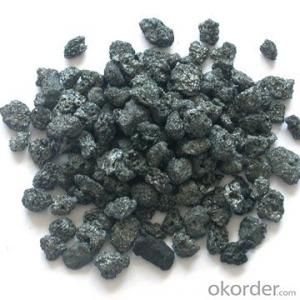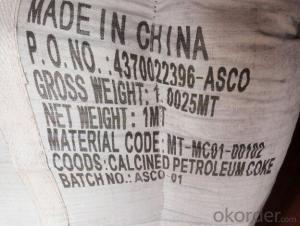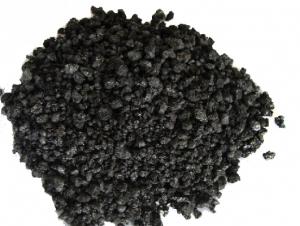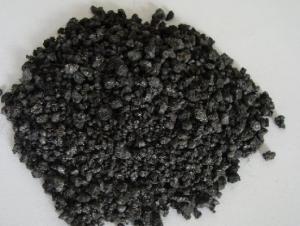Calcined Peroleum Coke with FC 98.5% S 0.5%max
- Loading Port:
- Tianjin
- Payment Terms:
- TT OR LC
- Min Order Qty:
- 20 m.t.
- Supply Capability:
- 2000 m.t./month
OKorder Service Pledge
OKorder Financial Service
You Might Also Like
Packaging & Delivery
25kg paper bag into 1t weaving bag 5kg, 10kg and 20kg weaving bag into 1t weaving bag 25kg weaving bag put on pallet covered with entanglement wrap product direct into packing bag 25kg paper bag put on pallet covered with entanglement Wrap 25kg weaving bag into 1t weaving bag
Calcined Petroleum Coke is a critical ingredient in the production of Metallurgy and chemical industrial ,it can increase the used quantity of Scrap steel and reduce the quantity of Scrap iron, or use no Scrap iron at all, the calcined petroleum coke has follow properties: high absorptive character, no residue will be left and save production cost.
Calcined Petroleum Coke comes from delayed coke which extracted from oil refinery. Although Calcined Petroleum Coke contains a little bit higher level of sulfur and nitrogen than pitch coke, the price advantage still makes it widely used during steel-making and founding as a kind of carbon additive/carburant.
General Specification of Calcined Anthracite:
| FC % | 98.5 | 98.5 | 98.5 | 99 |
| ASH % | 0.8 | 0.8 | 0.8 | 0.5 |
| V.M. % | 0.7 | 0.7 | 0.7 | 0.5 |
| S % | 0.5 | 0.55 | 0.7 | 0.5 |
| MOISTURE % | 0.5 | 0.5 | 0.5 | 0.5 |
Picture of CPC/ Calcined Petroleum Coke
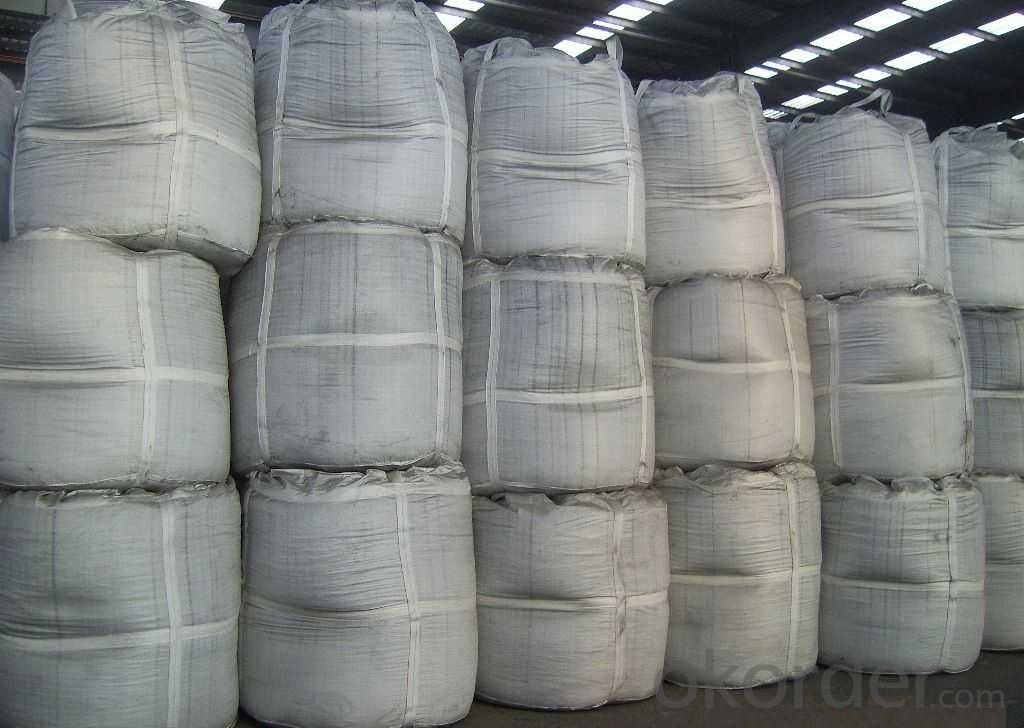
- Q: What is the effect of carbon equivalent on welding?
- Carbon equivalent is the conversion of various alloying elements in steel to carbon content! Carbon and alloying elements in steel have different effects on weldability of steel. Carbon has the greatest impact, and other alloy elements can be converted into carbon to estimate the weldability of the welded material. The converted sum is called the carbon equivalent! In Li Guang is used in carbon steel Q235, so if you just want to know welding business, ha ha, can put the carbon steel as the approximation of the carbon equivalent, carbon equivalent higher welding performance worse!
- Q: What are fullerenes?
- Fullerenes are a class of carbon molecules that have a unique structure resembling hollow spheres, tubes, or other shapes. They are made entirely of carbon atoms, forming a cage-like structure. Fullerenes can have different sizes and arrangements of carbon atoms, with the most famous one being the buckyball, consisting of 60 carbon atoms arranged in a soccer ball-like shape. These molecules have various applications in technology, medicine, and materials science due to their exceptional physical and chemical properties.
- Q: What does carbon nanotubes (5,5) in (5,5) mean?
- 3. get (5,5) after the initial point (0,0) to draw a line, this line is the circumference of the carbon nanotubes.
- Q: What are the properties of carbon-based textiles?
- Carbon-based textiles have a number of unique properties that make them advantageous in various applications. Firstly, carbon-based textiles exhibit exceptional strength and durability. They are known for their high tensile strength, making them resistant to stretching and tearing. This property allows carbon textiles to withstand harsh conditions and maintain their integrity over time. Secondly, carbon-based textiles possess excellent thermal conductivity. They can efficiently conduct heat, making them suitable for applications that require effective heat management. This property is particularly useful in industries such as aerospace, automotive, and electronics, where heat dissipation is essential to prevent system failures. Furthermore, carbon textiles are highly resistant to chemical corrosion. They can withstand exposure to various chemicals, acids, and solvents without losing their structural integrity. This property makes carbon-based textiles ideal for applications in the chemical industry, where exposure to corrosive substances is common. Another notable property of carbon textiles is their inherent flame resistance. They have a high resistance to ignition and do not propagate flames easily. This characteristic makes them suitable for use in environments where fire safety is crucial, such as in protective clothing for firefighters and military personnel. Carbon-based textiles also exhibit good electrical conductivity, making them suitable for applications in electronics and electrical engineering. They can effectively conduct electricity and dissipate static charges, reducing the risk of electrical malfunctions or damage. Lastly, carbon textiles have a low coefficient of thermal expansion, meaning they do not expand or contract significantly with changes in temperature. This property makes them dimensionally stable, ensuring that they maintain their shape and size under varying thermal conditions. In summary, carbon-based textiles possess a combination of strength, durability, thermal conductivity, chemical resistance, flame resistance, electrical conductivity, and dimensional stability. These properties make them highly versatile and suitable for a wide range of applications in various industries.
- Q: How does carbon dioxide affect climate change?
- Climate change is significantly influenced by carbon dioxide (CO2), a greenhouse gas. CO2 is released into the atmosphere through natural processes like volcanic eruptions or human activities such as burning fossil fuels. Its presence in the atmosphere traps heat from the sun, preventing it from escaping back into space. This phenomenon is known as the greenhouse effect. Human activities, particularly the burning of fossil fuels like coal, oil, and natural gas, have led to an imbalance in the natural carbon cycle. This has caused an increase in CO2 concentration in the atmosphere, resulting in a rapid rise in global CO2 levels. Consequently, the Earth's surface is warming, and climate patterns are changing. Since the Industrial Revolution, the burning of fossil fuels has significantly elevated atmospheric CO2 levels, leading to an increase in the Earth's average temperature. This temperature rise impacts various aspects of the climate system, causing a range of effects. One of the most visible outcomes of increased CO2 levels is global warming. This warming leads to the melting of glaciers and polar ice, which in turn raises sea levels. Rising sea levels pose a threat to coastal areas and low-lying islands, causing increased flooding, coastal erosion, and potential displacement of communities. Moreover, elevated CO2 levels contribute to more frequent and intense heatwaves, droughts, and wildfires in many regions. These extreme weather events negatively affect agriculture, water availability, and human health. Carbon dioxide also disrupts ecosystems by altering the growth patterns and distribution of plant and animal species. Changes in temperature and precipitation patterns, driven by increased CO2 levels, disturb the delicate balance of life, leading to biodiversity loss and potential species extinction. To mitigate the impacts of CO2 on climate change, it is crucial to reduce greenhouse gas emissions. Transitioning to renewable energy sources, improving energy efficiency, and adopting sustainable practices are important steps in reducing CO2 emissions and limiting the extent of climate change. Additionally, efforts to restore and protect forests and other natural carbon sinks can help absorb and store CO2, thus mitigating its effects on the climate.
- Q: How do you remove the carbon stains on your clothes?
- 1, first pour alcohol on clothes, fountain pen scratches, every scratch should be evenly covered with alcohol, alcohol should be used at a concentration of not less than 75% of the medical alcohol.2, pour the clothes down, put this side of the alcohol up, try not to touch other surfaces of the clothes, otherwise, the color of the pen or ballpoint pen may be stained with other parts of the clothes.3, with ordinary washbasin, ready most of the basin of water, and then will be full of two bottles of bleach water poured in the water, pay attention to must be full two bottle cap.4, take a stir, and then add a little washing powder, this amount can be mastered.5, after a little mixing, so that washing powder can be fully dissolved in water. Well, now soak your clothes in water for twenty minutes.
- Q: What is carbon capture and storage?
- The aim of carbon capture and storage (CCS) technology is to lessen carbon dioxide (CO2) emissions from major sources like industrial processes, power plants, and others. It works by capturing CO2 emissions before they are released into the atmosphere and then storing them securely underground. To capture carbon, specialized equipment is typically used to trap CO2 from flue gases or industrial processes. The captured CO2 is then compressed and transported through pipelines or ships to a suitable storage site located deep underground. These storage sites can include depleted oil and gas fields, saline aquifers, or deep coal seams. The storage process ensures long-term containment of CO2 and reduces the risk of leakage. This is achieved by monitoring the storage site for signs of leakage, maintaining the integrity of the storage infrastructure, and selecting suitable sites with geological features that aid in long-term CO2 containment. Carbon capture and storage has the potential to greatly reduce CO2 emissions and contribute to climate change mitigation. By capturing and storing CO2 instead of releasing it into the atmosphere, industries can continue using fossil fuels while minimizing their environmental impact. This is particularly beneficial for industries that are challenging to decarbonize, such as cement production, steel manufacturing, and natural gas power plants. Despite its promise, the widespread implementation of carbon capture and storage faces challenges and limitations. One significant challenge is the high cost associated with establishing CCS infrastructure and operations. Additionally, finding suitable storage sites and addressing public concerns about the safety and environmental impact of underground CO2 injection can pose significant obstacles. Nevertheless, carbon capture and storage is considered an essential tool in the battle against climate change. It can play a crucial role in achieving global emission reduction goals and transitioning to a low-carbon economy. With advancing technology and decreasing costs, the widespread adoption of carbon capture and storage may become increasingly feasible and necessary.
- Q: How do you make your own carbon fiber bar?Know. ID is how to make? Don't copy anything that has nothing to do with it
- 3. carbon fiber product form and manufacturing process carbon fiber has four kinds of products: fiber, fabric, prepreg, and chopped fiber. Cloth refers to fabric made from carbon fibers. Prepreg is a product in which carbon fibers are aligned in one direction and impregnated with carbon fibers or fabrics to form sheets. A staple fiber is a short fiber. These products, together with resins, will form carbon fiber reinforced plastics (CFRP) at different ratios. The resin is attached to the fiber and can be made into a pressure vessel and roll, which is wound around a core and then plasticized or hardened. This method is called "winding forming method"". Put the cloth into a model, and then soak it with resin. It can also be the body part of the production card. This is the "method of resin transfer molding (RTM)". The manufacture of aircraft elements is made by heating, pressing and plasticizing preforms in a autoclave. A strand of prepreg is wrapped around a core and heated and plasticized. This is known as the sheet winding method, which can be used to make a golf club, a fishing rod. The short silk is mixed with resin to form a mixture, which can be used to produce mountain machine components and other products after processing. In the past, prepreg was the most widely used form of carbon fiber, fabricated by sheet winding in a reactor. Recently, however, with the development of new industrial applications, filament winding, blending and other methods of prefabrication have been developed more widely. The use of molding such as RTM has enabled manufacturers to make larger products more efficiently. The combination of carbon fiber with the most suitable resin and prefabrication process makes the application of carbon fiber more attractive.
- Q: How are carbon fibers used in manufacturing?
- Due to their exceptional strength, low weight, and high stiffness, carbon fibers are widely employed in manufacturing. Typically, these fibers are combined with a matrix material, like epoxy resin, to produce composite materials with enhanced properties. The aerospace industry extensively utilizes carbon fibers in manufacturing. These fibers, when used in carbon fiber composites, are employed to fabricate lightweight and robust components for aircraft and spacecraft, including wings, fuselages, and propellers. The carbon fibers' high strength-to-weight ratio enables improved fuel efficiency and increased payload capacity. In the automotive industry, carbon fibers are incorporated into the production of high-performance vehicles. By integrating carbon fiber composites into car body construction, manufacturers can reduce weight, enhance fuel efficiency, and improve overall performance. Carbon fibers are also utilized in the manufacturing of various car components, such as steering wheels, brake systems, and suspension parts, to bolster their strength and durability. The sporting goods industry extensively employs carbon fiber composites. These composites are commonly used in the fabrication of bicycles, tennis rackets, golf clubs, and fishing rods, among other applications. The utilization of carbon fibers in these contexts results in lighter and more responsive equipment, leading to improved performance for athletes. Furthermore, the construction industry finds applications for carbon fibers. They are employed to reinforce concrete structures, such as bridges and buildings, to enhance their strength and durability. Additionally, carbon fiber-reinforced polymers (CFRPs) are utilized for the repair and retrofitting of existing structures, providing increased strength and extending their lifespan. In conclusion, carbon fibers are employed in manufacturing to create composite materials that are lightweight, strong, and durable. Their applications span various industries, including aerospace, automotive, sporting goods, and construction. The utilization of carbon fibers offers numerous benefits, including improved performance, fuel efficiency, and overall product quality.
- Q: There are several allotropes of carbon
- Allotrope of carbon: diamond, graphite, carbon 60 (fullerene), amorphous carbon (charcoal, coke, activated carbon, etc.)
Send your message to us
Calcined Peroleum Coke with FC 98.5% S 0.5%max
- Loading Port:
- Tianjin
- Payment Terms:
- TT OR LC
- Min Order Qty:
- 20 m.t.
- Supply Capability:
- 2000 m.t./month
OKorder Service Pledge
OKorder Financial Service
Similar products
Hot products
Hot Searches


